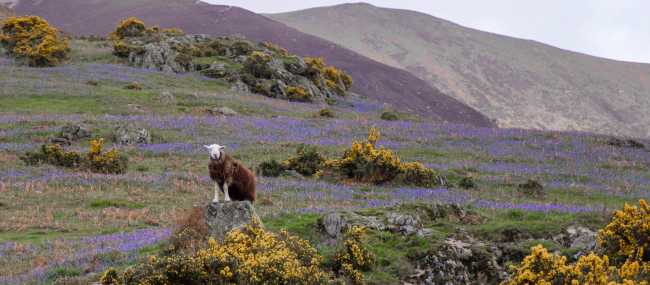
Sheep in bluebell fields in the Lake District | Ray Cross
Blog home / Guide to Sheep Spotting on an English Walking Holiday
One of the greatest joys of a walking holiday in Britain is the feeling of sharing the landscape with its original locals—the sheep. With over 90 different breeds across the UK, these woolly characters are more than just scenic backdrops to your journey. They are hardy, historic, and often downright adorable.
As you make your way along our trails—from the craggy fells of the Lake District to the sun-dappled hills of the Cotswolds—you’re walking through the homeland of some of the world’s most iconic sheep breeds. Here's who you might bump into along the way…
Who You’ll Meet on the Trail
Scottish Blackface
Lake District, Yorkshire Dales, Scottish Highlands
Often seen grazing high on windswept ridges, this breed has been here since the 1750s. They’re rugged and built for altitude—just like many of our walkers!
Herdwick
Lake District
Possibly descended from Viking sheep, these grey-coated locals are experts at navigating steep ground. They’re also fiercely loyal to their home range (a behaviour known as hefting)—just like you might be after discovering the Lakes.
Texel
Everywhere from Cornwall to Cumbria
You’ll spot these stocky sheep all over the UK. Originally from the Netherlands, they’ve made themselves very much at home in British pastures.
Bluefaced Leicester & Mules
Nationwide
The Roman-nosed Bluefaced Leicester is a common sight in lowland fields. Their offspring, Mules, are often the friendly faces peering at you from behind a gate or dry-stone wall.
Cheviot
The Pennines, Scottish Borders
If you're walking Offa’s Dyke or venturing across the wilds of the Borders, look out for these classic white-faced sheep. They’re strong, independent, and just a little feisty—ideal trail companions!
Swaledale
Yorkshire Dales, Lake District
Recognisable by their curled horns and black faces with white rings around the eyes, Swaledales are true icons of the north. They’re as much a part of the upland scenery as the fells themselves.
Welsh Mountain Sheep
Snowdonia Slate Trail, Offa’s Dyke Path
Small, scrappy, and incredibly tough, these white-faced sheep are perfect for the rugged terrain you’ll explore in Wales. Bonus: they pose beautifully for trail photos.
Southdown
South Downs Way, Dorset Coast Path
Stroll along chalky coastal ridges and you’ll find these teddy bear-like sheep grazing peacefully beside your path.
Rarer Breeds to Look Out For
Cotswold Sheep
Cotswold Way
Once known as the “Cotswold Lions,” these long-woolled sheep are majestic to behold. Spotting one on a walk feels like discovering a piece of living history.
Manx Loaghtan
Isle of Man Coast Path
A true trail treasure—these rare, mousey-brown sheep can have up to six spiralling horns! One of the many quirky delights you’ll encounter while hiking the coastal circuit of the Isle of Man.
Did Ewe Know? Trailside Trivia to Impress Your Walking Companions
-
Sheep were first domesticated around 6000 BC, and they’ve been part of the walking landscape ever since.
-
Wool is naturally fire-resistant. Great to know if you’re warming up near a log burner after a day on the trail.
-
These clever creatures can recognise human faces and even solve simple problems, like opening gates. (Which explains how they sometimes turn up on the wrong side of a fence!)
-
Most sheep are resistant to snake venom. Useful if you’re sharing a trail with adders!
-
While they can swim, their wool makes it challenge - so don’t expect any sheepy synchronised swimming displays.
-
They have an incredible 270–320° field of vision. Ideal for spotting dogs, walkers, and suspicious hikers with trail snacks.
-
Sheep have scent glands on their feet and faces. They leave invisible calling cards all over the hills.
-
Sheep pregnancies last about 145 days. Ram goes in on Bonfire Night, lambs arrive on April Fool's Day.
“In with a bang, out like fools!”
So Next Time You’re Walking…
…don’t just admire the views. Take a moment to appreciate the four-legged residents who’ve shaped the landscape you’re exploring. Their ancestors grazed these same hills and valleys centuries before hiking boots were invented, and their presence brings character, charm, and a true sense of place to your walking holiday.
Because they’re not just sheep. They’re storytellers, trailblazers, and fellow travellers in their own right.
So go on—next time you see one, give a cheerful:
“What are Ewe?”
And maybe, just maybe, the hill will echo back:
“I am a Ewe!”
Want to walk with sheep?
Check out our walking holidays through the Lake District, Snowdonia, the South Downs, the Cotswolds, and more—where you can share the path with these woolly wanderers (and maybe pick up a few sheep facts along the way).